[English] 日本語
 Yorodumi
Yorodumi- PDB-1d00: STRUCTURE OF TNF RECEPTOR ASSOCIATED FACTOR 2 IN COMPLEX WITH A 5... -
+ Open data
Open data
- Basic information
Basic information
| Entry | Database: PDB / ID: 1d00 | ||||||
|---|---|---|---|---|---|---|---|
| Title | STRUCTURE OF TNF RECEPTOR ASSOCIATED FACTOR 2 IN COMPLEX WITH A 5-RESIDUE CD40 PEPTIDE | ||||||
 Components Components |
| ||||||
 Keywords Keywords | APOPTOSIS / B-SANDWICH / PROTEIN-PEPTIDE COMPLEX | ||||||
| Function / homology |  Function and homology information Function and homology informationTORC2 complex disassembly / cellular response to erythropoietin / CD40 receptor binding / TORC1 complex assembly / tumor necrosis factor receptor superfamily complex / varicosity / sphingolipid binding / B cell mediated immunity / positive regulation of interleukin-4-mediated signaling pathway / immune response-regulating cell surface receptor signaling pathway ...TORC2 complex disassembly / cellular response to erythropoietin / CD40 receptor binding / TORC1 complex assembly / tumor necrosis factor receptor superfamily complex / varicosity / sphingolipid binding / B cell mediated immunity / positive regulation of interleukin-4-mediated signaling pathway / immune response-regulating cell surface receptor signaling pathway / TRAF2-GSTP1 complex / tumor necrosis factor binding / IRE1-TRAF2-ASK1 complex / CD27 signaling pathway / Defective RIPK1-mediated regulated necrosis / TNF receptor superfamily (TNFSF) members mediating non-canonical NF-kB pathway / TNF signaling / CD40 signaling pathway / Regulation by c-FLIP / CASP8 activity is inhibited / Dimerization of procaspase-8 / negative regulation of glial cell apoptotic process / interleukin-17-mediated signaling pathway / CD40 receptor complex / programmed necrotic cell death / positive regulation of isotype switching to IgG isotypes / response to cobalamin / Caspase activation via Death Receptors in the presence of ligand / positive regulation of tumor necrosis factor-mediated signaling pathway / thioesterase binding / tumor necrosis factor receptor binding / mRNA stabilization / regulation of immunoglobulin production / non-canonical NF-kappaB signal transduction / vesicle membrane / mitogen-activated protein kinase kinase kinase binding / regulation of JNK cascade / positive regulation of extrinsic apoptotic signaling pathway / signal transduction involved in regulation of gene expression / TNFR1-induced proapoptotic signaling / positive regulation of protein kinase C signaling / TRAF6 mediated IRF7 activation / RIPK1-mediated regulated necrosis / defense response to protozoan / positive regulation of JUN kinase activity / TRAF6 mediated NF-kB activation / B cell activation / B cell proliferation / intrinsic apoptotic signaling pathway in response to endoplasmic reticulum stress / positive regulation of endothelial cell apoptotic process / positive regulation of blood vessel endothelial cell migration / protein K63-linked ubiquitination / cellular response to interleukin-1 / cell surface receptor signaling pathway via JAK-STAT / ubiquitin ligase complex / regulation of protein-containing complex assembly / response to type II interferon / antigen binding / protein autoubiquitination / positive regulation of B cell proliferation / positive regulation of interleukin-12 production / signaling adaptor activity / cellular response to nitric oxide / positive regulation of interleukin-2 production / T cell activation / response to endoplasmic reticulum stress / tumor necrosis factor-mediated signaling pathway / TNFR1-induced NF-kappa-B signaling pathway / Regulation of NF-kappa B signaling / TNFR2 non-canonical NF-kB pathway / phosphatidylinositol 3-kinase/protein kinase B signal transduction / protein catabolic process / Regulation of TNFR1 signaling / cellular response to mechanical stimulus / : / positive regulation of T cell cytokine production / RING-type E3 ubiquitin transferase / platelet activation / Regulation of necroptotic cell death / cytoplasmic side of plasma membrane / intracellular calcium ion homeostasis / positive regulation of angiogenesis / Immunoregulatory interactions between a Lymphoid and a non-Lymphoid cell / ubiquitin-protein transferase activity / cellular response to tumor necrosis factor / ubiquitin protein ligase activity / signaling receptor activity / cellular response to lipopolysaccharide / protein-containing complex assembly / cell cortex / protein phosphatase binding / regulation of apoptotic process / protein-macromolecule adaptor activity / defense response to virus / positive regulation of canonical NF-kappaB signal transduction / positive regulation of MAPK cascade / Ub-specific processing proteases / membrane raft / inflammatory response / protein domain specific binding Similarity search - Function | ||||||
| Biological species |  Homo sapiens (human) Homo sapiens (human) | ||||||
| Method |  X-RAY DIFFRACTION / X-RAY DIFFRACTION /  SYNCHROTRON / Resolution: 2 Å SYNCHROTRON / Resolution: 2 Å | ||||||
 Authors Authors | Ye, H. / Park, Y.C. / Kreishman, M. / Kieff, E. / Wu, H. | ||||||
 Citation Citation |  Journal: Mol.Cell / Year: 1999 Journal: Mol.Cell / Year: 1999Title: The structural basis for the recognition of diverse receptor sequences by TRAF2. Authors: Ye, H. / Park, Y.C. / Kreishman, M. / Kieff, E. / Wu, H. #1:  Journal: Nature / Year: 1999 Journal: Nature / Year: 1999Title: Structural Basis for Self-Association and Receptor Recognition of Human Traf2 Authors: Park, Y.C. / Burkitt, V. / Villa, A.R. / Tong, L. / Wu, H. | ||||||
| History |
|
- Structure visualization
Structure visualization
| Structure viewer | Molecule:  Molmil Molmil Jmol/JSmol Jmol/JSmol |
|---|
- Downloads & links
Downloads & links
- Download
Download
| PDBx/mmCIF format |  1d00.cif.gz 1d00.cif.gz | 262 KB | Display |  PDBx/mmCIF format PDBx/mmCIF format |
|---|---|---|---|---|
| PDB format |  pdb1d00.ent.gz pdb1d00.ent.gz | 211 KB | Display |  PDB format PDB format |
| PDBx/mmJSON format |  1d00.json.gz 1d00.json.gz | Tree view |  PDBx/mmJSON format PDBx/mmJSON format | |
| Others |  Other downloads Other downloads |
-Validation report
| Summary document |  1d00_validation.pdf.gz 1d00_validation.pdf.gz | 436.4 KB | Display |  wwPDB validaton report wwPDB validaton report |
|---|---|---|---|---|
| Full document |  1d00_full_validation.pdf.gz 1d00_full_validation.pdf.gz | 467 KB | Display | |
| Data in XML |  1d00_validation.xml.gz 1d00_validation.xml.gz | 30.8 KB | Display | |
| Data in CIF |  1d00_validation.cif.gz 1d00_validation.cif.gz | 46.9 KB | Display | |
| Arichive directory |  https://data.pdbj.org/pub/pdb/validation_reports/d0/1d00 https://data.pdbj.org/pub/pdb/validation_reports/d0/1d00 ftp://data.pdbj.org/pub/pdb/validation_reports/d0/1d00 ftp://data.pdbj.org/pub/pdb/validation_reports/d0/1d00 | HTTPS FTP |
-Related structure data
- Links
Links
- Assembly
Assembly
| Deposited unit | 
| ||||||||
|---|---|---|---|---|---|---|---|---|---|
| 1 | 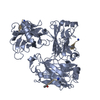
| ||||||||
| 2 | 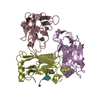
| ||||||||
| 3 | 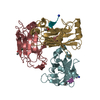
| ||||||||
| 4 | 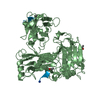
| ||||||||
| Unit cell |
|
- Components
Components
| #1: Protein | Mass: 19006.916 Da / Num. of mol.: 8 / Fragment: TRAF DOMAIN Source method: isolated from a genetically manipulated source Source: (gene. exp.)  Homo sapiens (human) / Plasmid: PET24D / Production host: Homo sapiens (human) / Plasmid: PET24D / Production host:  #2: Protein/peptide | Mass: 596.653 Da / Num. of mol.: 8 / Fragment: ACETYLATED 5-RESIDUE PEPTIDE / Source method: obtained synthetically Details: THIS PEPTIDE WAS CHEMICALLY SYNTHESIZED. THE SEQUENCE OF THIS PEPTIDE NATURALLY OCCURS IN HUMANS (HOMO SAPIENS) References: UniProt: P25942 #3: Water | ChemComp-HOH / | Has protein modification | Y | |
|---|
-Experimental details
-Experiment
| Experiment | Method:  X-RAY DIFFRACTION X-RAY DIFFRACTION |
|---|
- Sample preparation
Sample preparation
| Crystal | Density Matthews: 2.64 Å3/Da / Density % sol: 53.33 % | |||||||||||||||
|---|---|---|---|---|---|---|---|---|---|---|---|---|---|---|---|---|
| Crystal grow | Temperature: 293 K / Method: vapor diffusion / pH: 6 Details: PEG4K, MES, Ph6.0, VAPOR DIFFUSION, temperature 20K | |||||||||||||||
| Crystal grow | *PLUS pH: 6 / Method: unknown | |||||||||||||||
| Components of the solutions | *PLUS
|
-Data collection
| Diffraction | Mean temperature: 110 K |
|---|---|
| Diffraction source | Source:  SYNCHROTRON / Site: SYNCHROTRON / Site:  CHESS CHESS  / Beamline: A1 / Wavelength: 0.937 / Beamline: A1 / Wavelength: 0.937 |
| Detector | Type: ADSC / Detector: CCD / Date: Dec 1, 1998 |
| Radiation | Protocol: SINGLE WAVELENGTH / Monochromatic (M) / Laue (L): M / Scattering type: x-ray |
| Radiation wavelength | Wavelength: 0.937 Å / Relative weight: 1 |
| Reflection | Resolution: 2→20 Å / % possible obs: 100 % / Rmerge(I) obs: 0.055 |
| Reflection shell | Highest resolution: 2 Å / Rmerge(I) obs: 0.18 / % possible all: 99 |
| Reflection | *PLUS % possible obs: 100 % |
| Reflection shell | *PLUS % possible obs: 99.9 % / Rmerge(I) obs: 0.18 |
- Processing
Processing
| Software |
| ||||||||||||
|---|---|---|---|---|---|---|---|---|---|---|---|---|---|
| Refinement | Resolution: 2→20 Å / Rfactor Rfree: 0.254 / Rfactor Rwork: 0.219 / σ(F): 2 / σ(I): 0 | ||||||||||||
| Refinement step | Cycle: LAST / Resolution: 2→20 Å
|
 Movie
Movie Controller
Controller


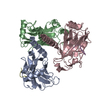

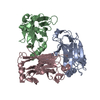
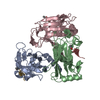

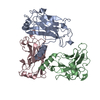


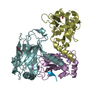
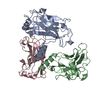
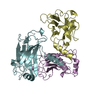
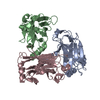
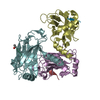
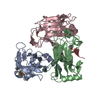
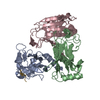
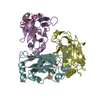
 PDBj
PDBj












